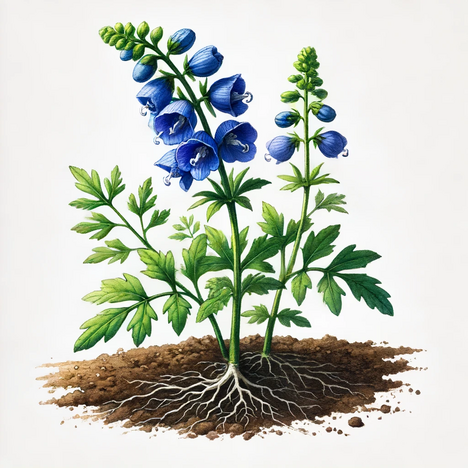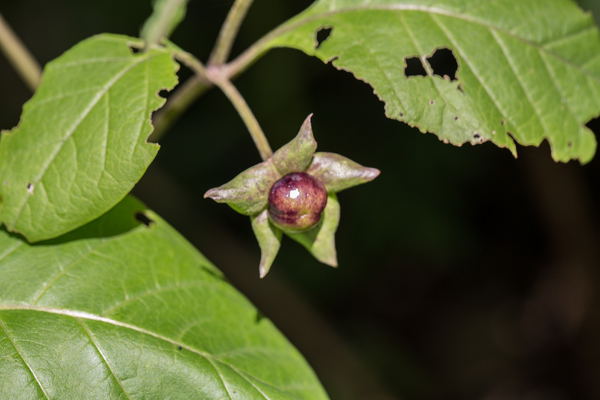Monkshood

What is aconite?
Monkshood (Aconitum napellus) belongs to the buttercup family (Ranunculaceae). This plant is mainly native to the temperate zones of the northern hemisphere and is often planted in gardens because of its attractive blue flowers. Monkshood can grow up to 1.5 meters tall and typically blooms from June to August.
Characteristics and distribution
The plant is characterized by its deep blue to purple flowers, which are arranged in dense clusters. Its leaves are dark green, palmately lobed and deeply incised. Monkshood prefers to grow in moist, nutrient-rich soil and is widespread in many parts of Europe, North America and Asia.
Toxicity of the monkshood
Monkshood is one of the most poisonous plants in Europe. All parts of the plant contain alkaloids, especially aconitine, which is known for its strong toxicity.
Effect on dogs
If your dog eats parts of aconite or even just licks it, this can have serious health consequences. Even small amounts of the plant can lead to symptoms of poisoning.
Symptoms of poisoning
The most common symptoms of aconite poisoning in dogs include
- Vomiting and diarrhea
- salivation
- Tremors and cramps
- Breathing difficulties
- Cardiac arrhythmia
In the worst case, poisoning can even be fatal. The effects usually occur very quickly, which is why it is essential to act quickly.
What to do if you suspect poisoning?
If you suspect that your dog has eaten aconite, you should consult a vet immediately. Try to take a sample of the plant with you so that the vet can make an accurate diagnosis. There are no specific antidotes to aconitine, but the vet can treat symptomatically and try to remove the poison from the body or mitigate its effects.
First aid measures
- Keep calm: Even if the situation is frightening, it is important to remain calm and act quickly.
- Call a vet: Call your vet or a veterinary clinic immediately and inform them of the suspected poisoning.
- Do not self-medicate: Do not try to make your dog vomit or give him medication on his own. This can make the situation worse.
Preventive measures
The best way to prevent aconite poisoning is to make sure your dog does not have access to this plant. Here are some tips:
- Check the garden: Remove all aconite plants from your garden if you have a dog.
- Be alert on walks: Make sure your dog doesn't nibble or lick unfamiliar plants.
- Training: Teach your dog to listen to the command "no" and not to eat plants indiscriminately.
Monkshood is a beautiful but highly poisonous plant that can pose a serious danger to dogs. It is important to recognize this plant and take measures to protect your dog from it. If you suspect that your dog has ingested aconite, do not hesitate to seek veterinary help immediately. With the right precautions and attention, you can ensure the safety of your faithful companion.
Properties 10
Are you looking for other ingredients with a specific property?
Just click on them to find more.
If you notice any signs of hypersensitivity or poisoning in your dog, you should see your vet immediately. We are not a substitute for a vet, but we try to be as accurate as possible. Every dog reacts differently and we recommend you get a second opinion or consult your vet if in doubt.
Stay healthy and take good care of your four-legged friend!😊
Similar to Monkshood
Foxglove belongs to the plantain family and is widespread in Europe, Asia and North America. There are around 20 different species of foxglove, which differ in the shape and color of their flowers....
The autumn crocus is a perennial plant that forms a brown-scaled bulb. This bulb survives the winter and produces new flowers the following fall. The flowers are funnel-shaped, have six equally...
Oleander (Nerium oleander) belongs to the dogbane family (Apocynaceae). It is an evergreen shrub that can grow up to six meters high in warm regions. Its dark green, leathery leaves are narrow and...
Belladonna (Atropa belladonna) is a perennial shrub from the nightshade family. It can grow up to two meters high and has egg-shaped leaves and bell-shaped flowers, which are brown-purple on the...



